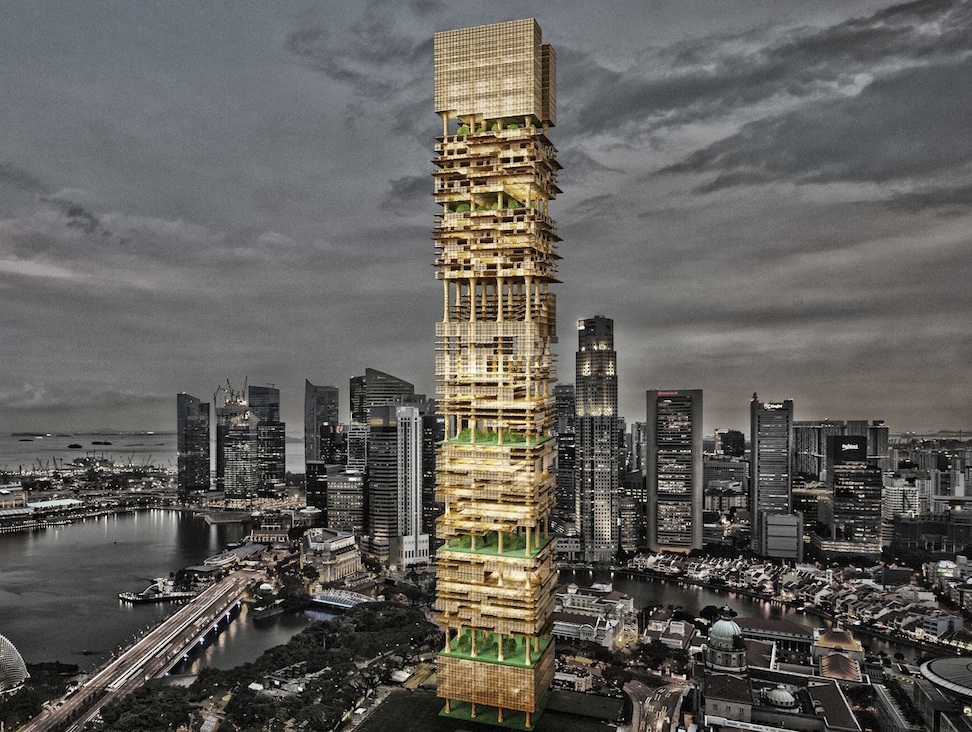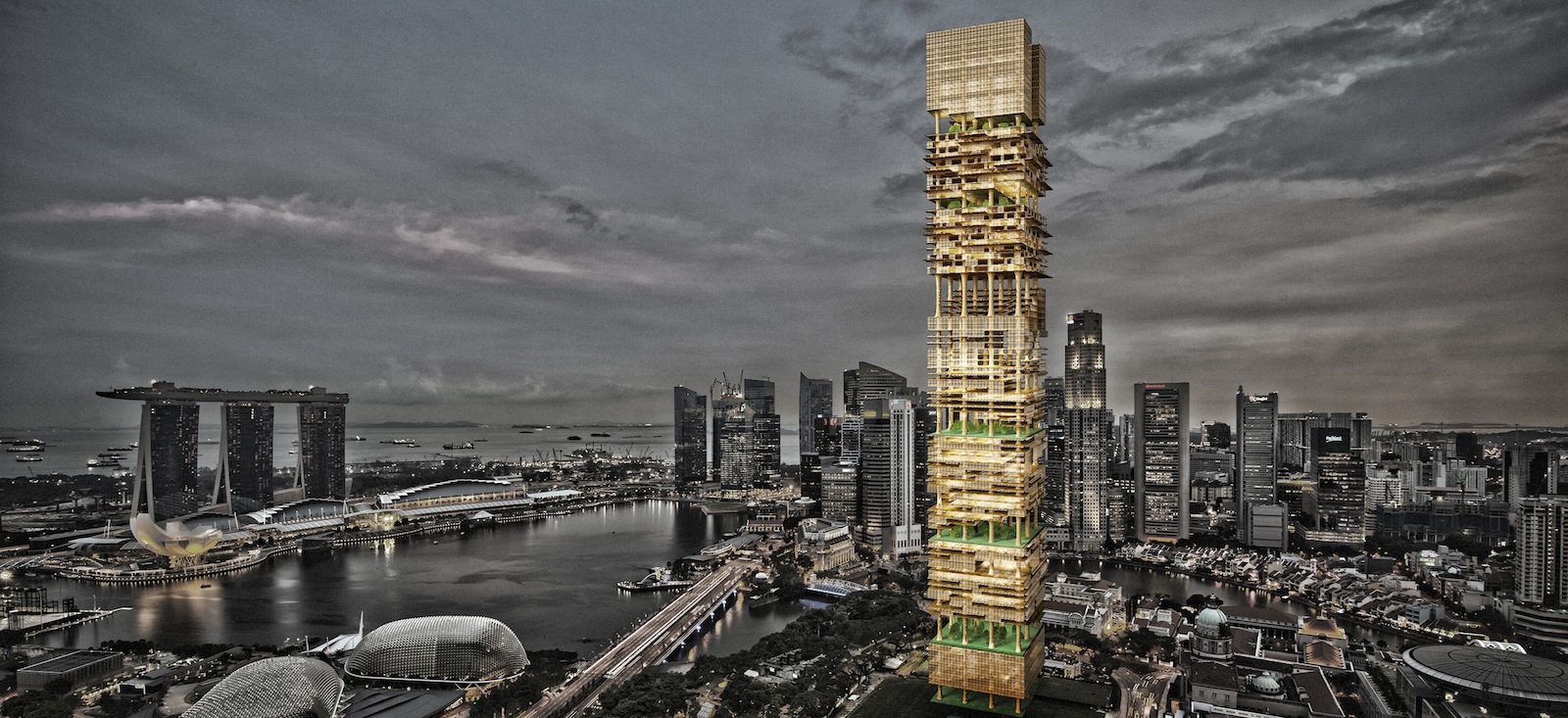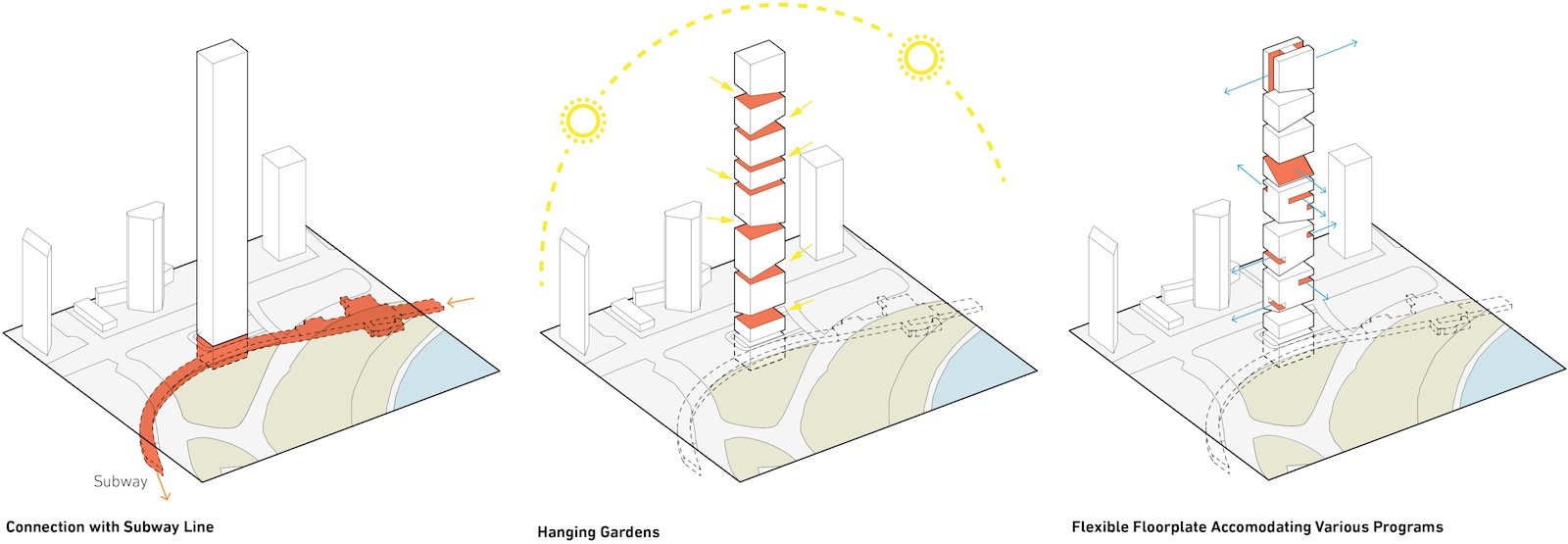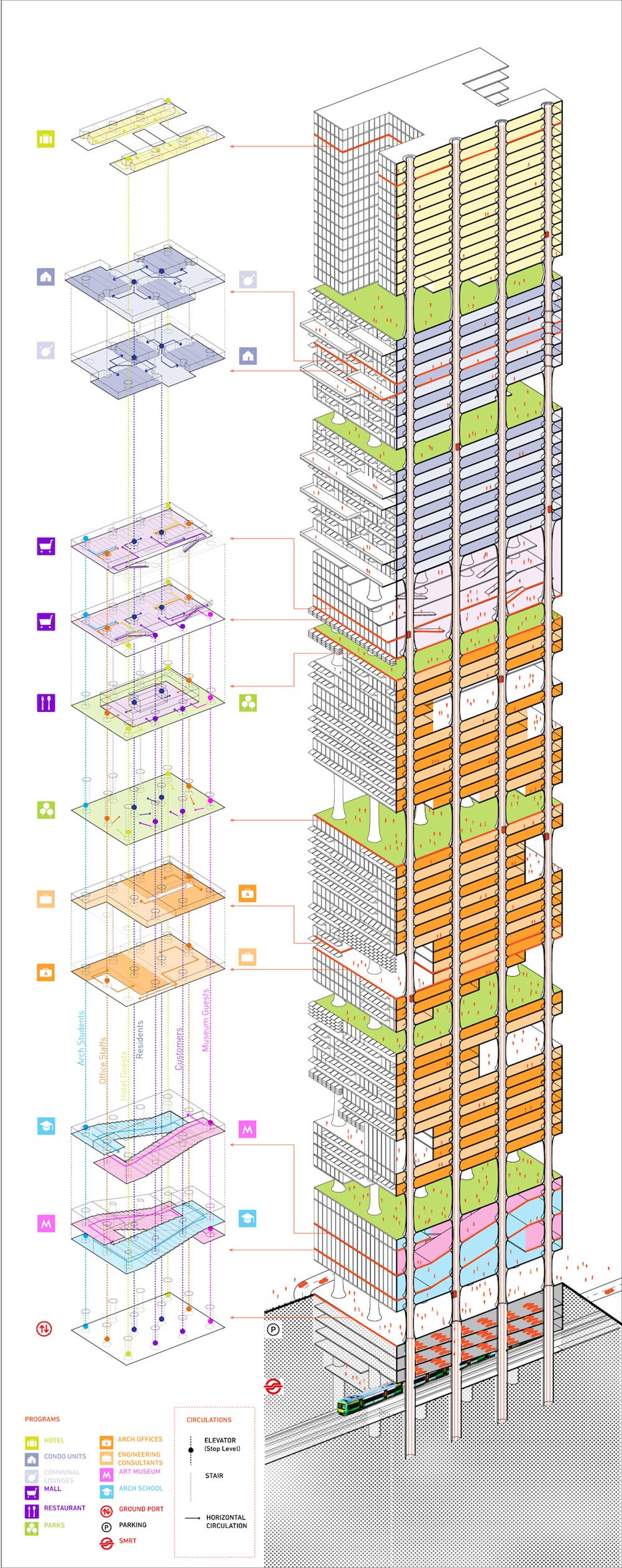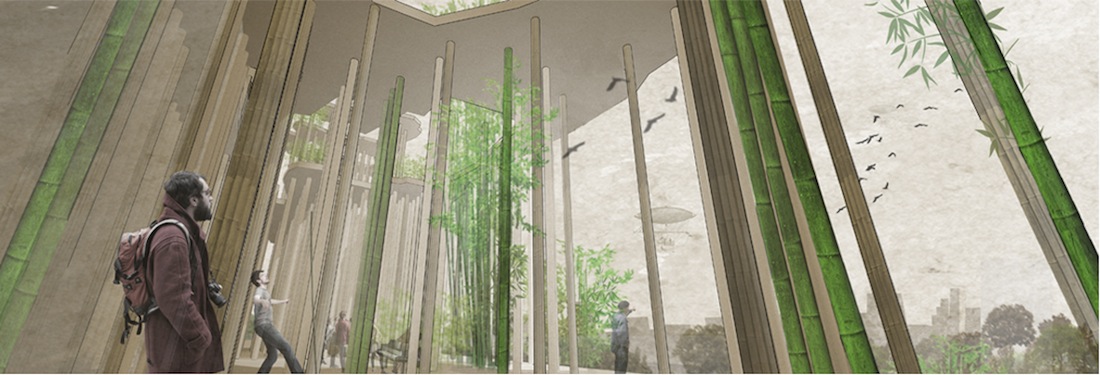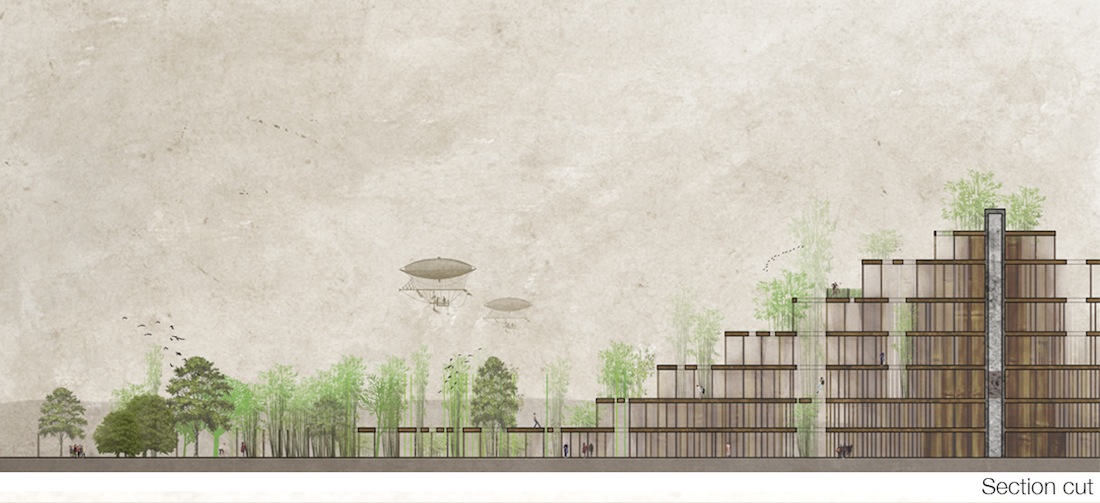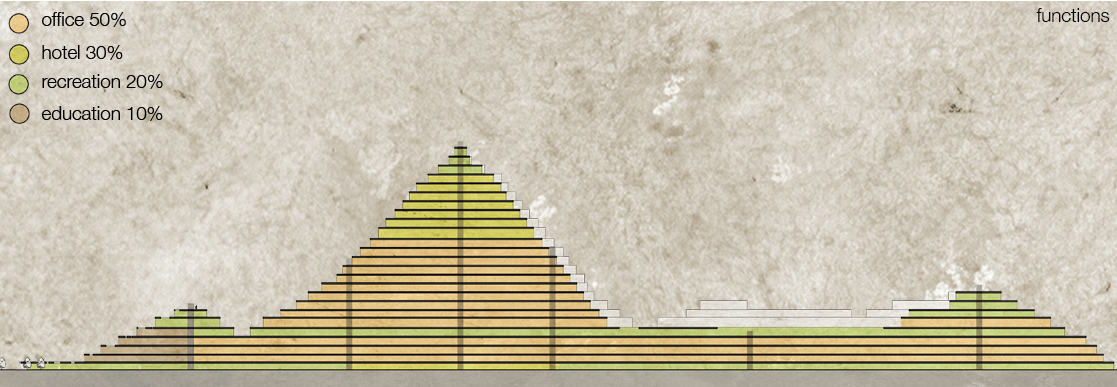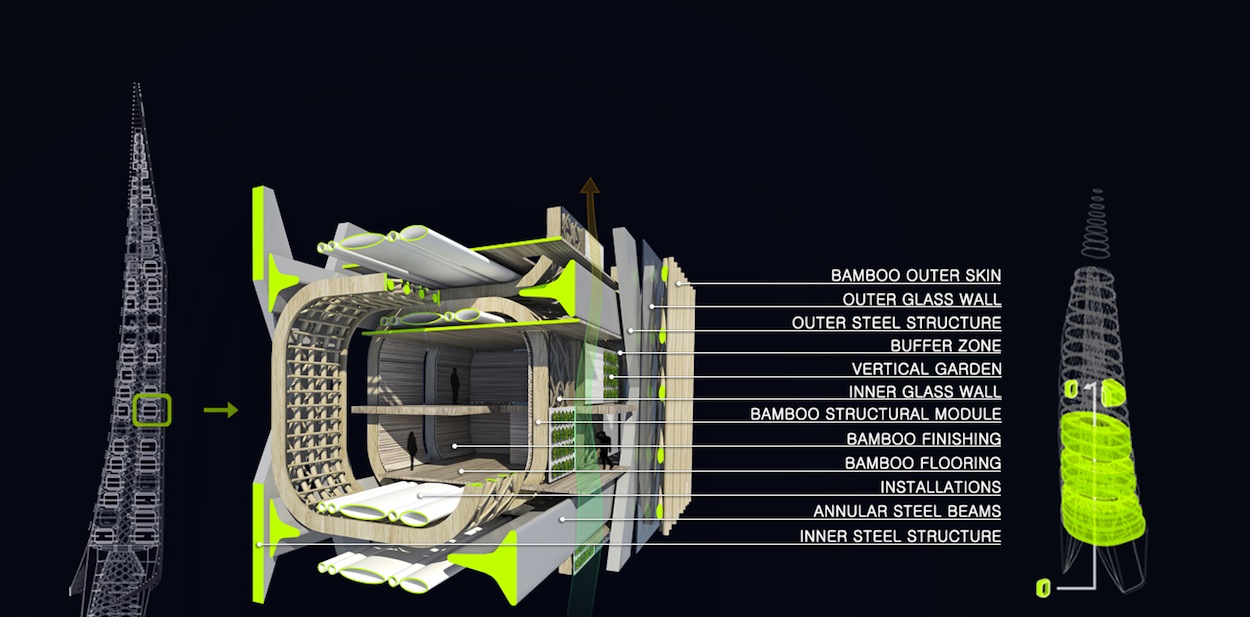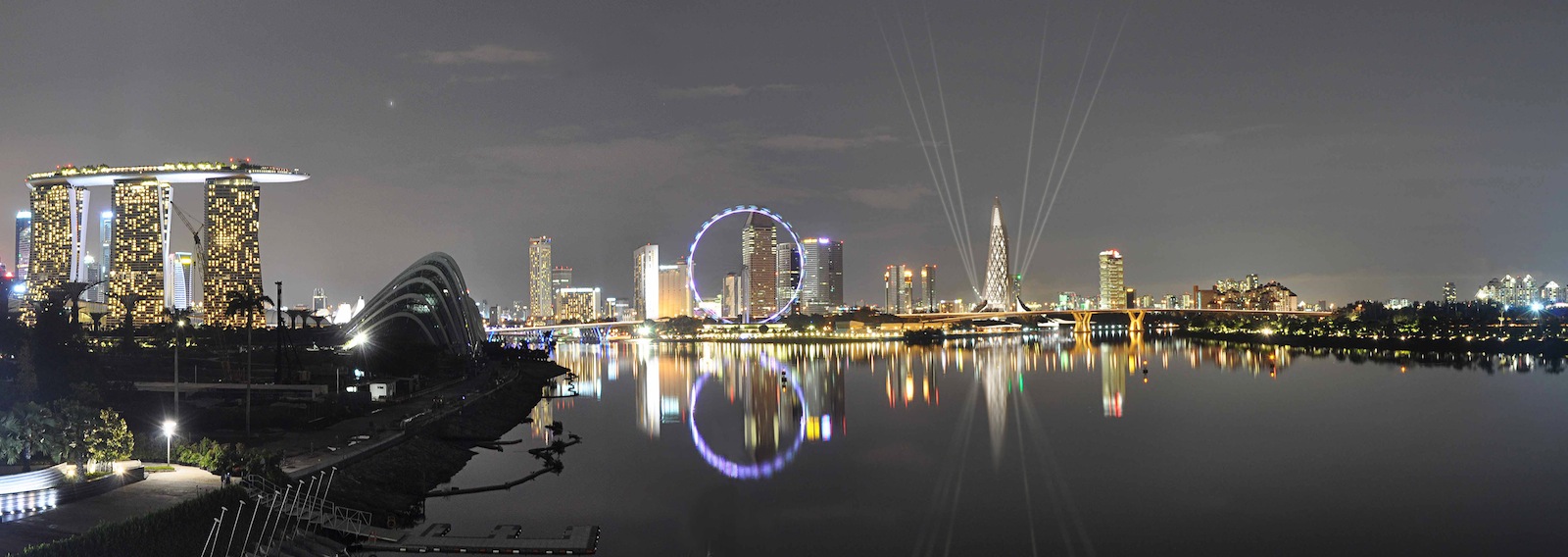Organized by the UK-based design competition site SuperSkyScrapers, the Singapore Bamboo Skyscraper competition invited design teams to explore the possibilities of using bamboo as the dominant material—structural or cladding—in a high-rise project for the Singapore skyline.
The competition jury, which included NYU Associate Professor Mitchell Joachim and architects Piotr Kuczia (Germany) and Damian Przybyla (Poland), was also interested in designs that proposed the growing, slicing, or reshaping of bamboo into fascinating shapes to be used for tall structure design.
Why bamboo?
The competition's organizers explain: Bamboo is a kind of grass, which explains the speed of growth. This means that there’s lots of it, and when it’s harvested it grows itself back again quickly enough not to leave a dent in the eco-system. Unlike all trees, individual bamboo stems emerge from the ground at their full diameter and grow to their full height in a single growing season of three to four months. During these several months, each new shoot grows vertically into a culm with no branching out until the majority of the mature height is reached.
Of the dozens of submissions, four were recognized by the jurors:
1st Place - The Bamboo Skyscraper
Judges' Comments
Design reveals critical, distinctive, high-quality, and innovative analysis of the competition theme with its clarity, quality of the model, very good presentation and beautiful rendering. The material enhances the design and the viewer can almost “feel” the material.
The general concept comes from an assumption of vertical urbanism and leads to convincing architectural solution of open spaces, which may be perceived as main avenues, that connect complex functions of the vertical city. The authors analyzed structural issues and looked for possible applications of the bamboo in such mega-structures. The result is an interesting re-interpretation of the usual concrete/steel frames using bamboo as a visible alternative to the steel and glass dominated skyscrapers.
Concept shows a great combination of strong ideological basis and a pragmatic, well presented architectural solution that is exceptionally sensitive and inspiring.
It is a successful implementation with proper relation to the place, good solutions for safety and functionality, great response to the climatic conditions of Singapore with sun protection with bamboo, stack effect, natural cross ventilation, water reuse system, analysis of regeneration of whole building, smart structural concept with good organization of space.
This project exhibits the quality of a real bamboo icon and a landmark for the city of Singapore.

CLICK HERE TO DOWNLOAD HIGH-RESOLUTION IMAGE OF POSTER
Project Details
Site Use - Site Area (m²): 3,500 m² - 54,835.37 m²
Building Area (m²): 261,160 m²
Gross Floor Area (m²): 339,508 m²
Building Coverage Ratio (%): 0.064%
Gross Floor Ratio (%): 1.3%
Building Scale: Mega Structure
Stories above Ground: 110
Stories below Ground: 6
Structure: Steam Bent Bamboo Stalks held together by Steel Bracket
Maximum Height (m²): 440 m
Landscape Area: 51,335 m²
Parking Lot: 10,500 m²
Exterior Finish: Operable Bamboo Screen
Design Team
Team Names: Mui Richard; Vilcu Alexandru; Wang Di
Country: Canada
Design Essay
The Bamboo Skyscraper was conceived as a section of a city that was flipped vertically. The major streets become the shafts, and the stores along those streets become the various programs at different levels. Like a street, these shafts house the major circulation and service armatures of city.
The building was situated on site to straddle the existing subway line and be encircled by the major roads. The building is raised off the ground to creating a free plan, allowing for circulation both horizontally and vertically.
The Bamboo Skyscraper is situated beside the forest on the site and on top of the Subway Station. The strategic siting allows for the preservation of existing landscape as well promoting public transit by making the Bamboo Skyscraper a destination in the public transit network.
The Bamboo Skyscraper is composed of one modular unit called the Tectonic Unit. This Tectonic unit is made from steam bent and arrayed bamboo stalks. As a result, each Tectonic Unit provides the floor, ceiling, vertical circulation, and access to the vertical circulation. These Tectonic Units make up floor slabs that can vary in three dimensions, optimizing each slab for the assigned program. Each program group is separated by a Skypark.
Structurally, the Bamboo Skyscraper has two pieces: the Tectonic Unit and vertical tubes within the Tectonic Unit for lateral bracing. The Bamboo stalks are connected together to form these two components using basic steel brackets. The result is a moment frame that works similarly to a concrete and steel moment frame.
Sustainability is inherent in the building design simply because it is made from bamboo. On a well managed 1000 hectare plantation, it would take 2 years to grow the amount of bamboo required to make this skyscraper. Further, the distributed organization of the circulation tubes allow them to contain sustainable functions like: water filtration for grey water use, stack effect for washroom ventilation, mist sprinkler system for fire protection.
Overall, the Bamboo Skyscraper is an extremely sustainable and renewable model for a flexible mixed use tower.
2nd Place - Self-sufficiency Urban Infrastructure
Judges' Comments
This project exhibits a strong awareness of possibilities of technology with a strong visual presentation that is rather witty, an unexpected concept with an amorphic form that correlates with attributes of bamboo as a building material (“elastic” skin).
The visual affinity with bamboo structure results in a nice, friendly architecture drawing attention to need for water management.
It is innovative in its approach of using environmental technologies and systems based on bamboo, however the structure, function and communication of all these expects could be clearer. The project on the whole, presents a delightful concept for a bamboo skyscraper.
Project Details
Site Use - Site Area (m²): 58,000m²
Building Area (m²): 4,459.28m²
Gross Floor Area (m²): 200,667.6m²
Building Coverage Ratio (%): 7.688%
Gross Floor Ratio (%): 345.98%
Building Scale: N/A -Skyscraper
Stories above Ground: 45 stories
Stories below Ground: 4 stories
Structure: Aluminum and Stainless Steel Frame Structure
Maximum Height (m): 225m
Landscape Area: 1,5970m²
Parking Lot: 720
Exterior Finish: Aluminum and Stainless Steel coated with waterproof painting, Glass

CLICK HERE TO DOWNLOAD HIGH-RESOLUTION IMAGE OF POSTER
Design Team
Team Names: Beobyeong Park | DongJun Kim | MinSung Kim | SeungGeun Kwak
Country: Republic of Korea
Design Essay
The concept is the life cycle of bamboo, the series of process that covers bamboo sprout coming out from the underground, bamboo growth, bamboo forest and eventually turning to charcoal. In addition, bamboo sprout, grown bamboo and effects of charcoal are reflected in this program (process).
Bamboo has rapid growth potential. It can grow more than 1 m per a day. Because of this surprising growth potential, this study grow bamboo in high-rise buildings and try to find how to use bamboo differently according to the life stage of bamboo. The purpose is to construct sustainable high-rise buildings that activate local economy and enhance competitiveness of a relevant city, with bamboo sprout, bamboo forest and bamboo charcoal, as well as preparing an environment friendly system that considers local circumstance.
3rd Place - The Bamboo Forest
Judges' Comments
Despite the schematic way of its presentation, the concept has great potential. Authors look for inspiration within nature and transpose it into interesting architectural solution. The organic layout of the building has been redefined into spatial and structural solution with the density of bamboo pillars higher in the central parts of the building (higher parts) and decreases towards exterior.
This principle bases on a structural analysis, but leads to interesting consequences regarding spatial and functional solutions. This building offers a soft spatial gradation between exterior and interior, there are no strict conventional walls, and in consequence building is integrated with a landscape. Interiors could be compared to bamboo forests filled with unified vertical elements.
Concept is presented in laconic way, which lacks great architectural execution. It doesn’t solve any detailed functional and environmental issues, but it can be perceived as an inspiring starting point – an ideology that offers a wide range of further interpretations and possibilities for a convincing detailed architectural solution.
Project Details
Site Use - Site Area (m²): 54 835 m2
Building Area (m²): 54 835 m2
Gross Floor Area (m²): 1 168 000 m2
Building Coverage Ratio (%): 100%
Gross Floor Ratio (%): 2130%
Building Scale: - Skyscraper
Stories above Ground: 40
Stories below Ground: 5
Structure: bamboo structure
Maximum Height (m²): 123 m
Landscape Area: 54 835 m2
Parking Lot: 274 175 m2
Exterior Finish: Bamboo | Concrete | Glass

CLICK HERE TO DOWNLOAD HIGH-RESOLUTION IMAGE OF POSTER
Design Team
Name/Team Names: Miloslav Olejar | Jakub Lenart | Tomas Boros
Country: Canada + Slovakia
Design Essay
We decided to place the bamboo skyscraper on the area of the whole property, which enabled us to decrease the problem of the static function of the whole building. At the edge of the transition between the surroundings and skyscrapers and at the same time dissipates the border between interior and exterior. We tried to integrate the whole building more into the space of the river and the surrounding green area than into the area of the urbanized town.
The type of material is not the only ecological part of the skyscraper, which we dealt with. We decided to appropriate central parts of the skyscraper for the air circulation of the whole building. Air is drawn away from the facade of the building and rises up in a chimney effect through the centre of each ground plan so the whole building can be cooled in natural manner.
The form of the skyscraper is reminiscent of hills where the highest point is placed where the widest floor plan of the property is. This hill creates a certain differentiation between the strict shapes of the skyscrapers, which expresses its material, and conceptual difference. While thinking of the form we clearly refuse all formal shapes and tried to turn towards simplicity even to a primitive natural form. This natural form enables air to flow and at the same time allows for the natural circulation of communication on the contours. This communication ramp curves around the whole skyscraper and connects the individually functioning nodes of the building.
There is also another type of communication vertically. These communication cores were always placed in the centre of a certain area; Since the whole form is based on the gradual liberation of the space from the middle into the edge of the building, we decided to lighten the edges of each floor with holes of various sizes and shapes. These holes also enable natural light in the deeper parts of the dispositions.
More stable and thicker construction was placed in the most burdened space. We therefore decided to build a skyscraper from wood based on the same system, which is the most natural for use with this building material. The columns were organized according to their width with the widest columns at the most burdened places while the others narrow leading out to the borders. This principle allowed us to easily organize the whole interior space.
Special Recognition - Archipelago
Judges' Comments
This proposal offers a plausible urban concept (Archipelago) with well thought out visual connections, very good presentation and coherent concept decreasing the environmental impact of the building: bio waste and water management, solar energy, natural ventilation (cool, green “cave” in the base of the building / stack effect), shading with bamboo elements, smart concept for wind energy harvesting and clear functional allocation.
It is a sophisticated, innovative structural concept (the “backbone” and the “cells”) and plausible use of bamboo as a construction material, reasonable mixed with steel and glass.
The slight disappointment is that bamboo is scarcely perceptible for the viewer outside of the building and the arbitrary, but pleasant form of the building. The proposal has potential for a landmark, however could exist on a site elsewhere.
Project Details
Site Use - Site Area (m²): 55 000 m2
Building Area (m²): 4 000 m2 (Skyscraper), 20 000 m2 (Islands)
Gross Floor Area (m²): 45 000 m2
Building Coverage Ratio (%): 7.2% (Skyscraper), 36.5% (Islands)
Gross Floor Ratio (%): 81.8%
Building Scale: Skyscraper
Stories above Ground: 62 including the inner harbor (“Cave”)
Stories below Ground: 0 within main skyscraper, 5 below parking building
Structure: bamboo and steel
Maximum Height (m²): 250 m
Landscape Area: 20 000 m2 (Islands Roof) , 15 000 m2 (Park)
Parking Lot: 5 Stories below and 5200 m2 (Parking Building)
Exterior Finish: Bamboo | Wood | Glass
Design Team
Team: DFG Architetti
Country: Italy
Design Essay
1. Concept - The Project starts from the analysis of the physical and social nature of Singapore, that is a country-city lying on an Archipelago of 63 islands and a cultural result of the fusion of many folks. The new sustainable bamboo Village, for that reason, consists of an Archipelago of volumes, among which stands out the Skyscraper. They all spread around a water Core, the Marina, calling back the close Marina Bay, in the Downtown Core.
2. Masterplan - The Masterplan is a configuration of many “functional islands”, settled around a central Core. The main volume, the Skyscraper, hosts the functions required from the program, while the other ones, lower and on the same level of the street, are the shell of ricreational spaces, sport facilities, educational structures, theaters and cinema. They overlook a central courtyard that consists in a small Marina, accessible from the Kallang River by a new waterway. Along the edge of the site there are gardens on the same level of the surrounding areas. Underneath the gardens, are placed underground parking, technical rooms, storages and support facilities of the infrastructural nodes. All the buildings are linked on more levels by plates that host the main routes, the squares, the shopping terraces, and the pier of the inner harbor. They have been designed for cycle-pedestrian flows but they can be crossed also by electric vehicles, or by shuttles.
The main access are: from East, by the Nicoll Highway Station; from North, by the Nicoll Highway, through pedestrian entrances; from West, through the new link to the Ophir Road and the Suntec City; from South, by the new infrastructural node between the Project and the ECP, from Republic Avenue; from South-East, by a new cycle-pedestrian path and the new water way to Marina Park and Kallang River. The main routes are the structural axes of the entire Project that link the main access to the Village, flowing toward the Core, where there is the access to the Skyscraper. Buildings and pathways are designed to allow the visual connections from the plates to the main landmarks of Singapore: The Flyer, Marina Park and the other surrounding buildings.
3. Cells - The Skyscraper consists in two concentric structural cylinders joined together by horizontal rings; inside this steel structure, independent self-supporting CELLS, made by a structural net of bamboo, are inserted. Each level of the building is design as a continuous tunnel, along which the CELLS are combined through the horizontal rings, assuming different configuration. The different assembly combination allows the design to achieve different and flexible spaces, depending on the function to allocate. Each CELL is easily replaceable in case of deterioration over time: this is done through a system of vertical movement within the central structural cylinder. The spaces thus defined are finished with removable bamboo paneling that facilitate the maintenance of the building and facilities, and are divided by movable partitions, adaptable to changing needs.
The Skyscraper is then covered with a double skin of glass and shading elements of bamboo, creating an air space for insulation and natural ventilation. The Skyscraper is composed for the most part from bamboo, in the form of structural CELLS and finishing, from a reduced percentage of steel, as a strictly necessary skeleton, and from a small part of glass.
4. Bioclimatic design - Two steel cylinders tied together by horizontal rings are the main structure of the Skyscraper and create the backbone and the housings for the CELLS. In each level they lay one beside the other, combined or separated depending on the spaces to configure, creating a continuous "tunnel".
The cell is designed as a hollow section of the tunnel, dimensioned to be able to be transported vertically through the internal structural cylinder, facilitating the assembly and the possible replacement. The Skyscraper is accessible from the cycle-pedestrian plates and through a navigable inland port, inside a large green Cave. It creates a large reservoir of fresh and humid air just below the warmer ventilation channels through the buffer zone and along the internal structural cylinder; the difference of pressure and the narrowing of the channels trigger natural ventilation.
The elevators are placed in the large pillars, which also give access to galleries around the Cave-Harbour, up to the first cell; from there up the elevators are contained in the internal structural cylinder. In some levels the absence of CELLS allows to create large inner squares for socializing, recreation and catering. The outer skin of bamboo allows for filtration of the strong outer light and it is designed according to the high angle of incidence of the sun, which is always very high throughout the year. It constitutes the distinctive “dress” of the Skyscraper, becoming a unique with the squares and external routes; the design of the bamboo elements of the outer skin and the CELLS allows to filter the strong sunlight and ensures the natural lighting, while in the first and last hours of the day creates plays of light and shadow on the inner surfaces of the interiors.
The outer skin is also an integrated system for the capture and collection of rainwater, which is stored, purified and reused. Bamboo is used both as a dress and structure and also in public spaces, along the route and in the squares. A thick tropical vegetation will be provided on the roof of each of the other buildings, so as to return a bit of the green that the expansion of the city has drastically reduced over time. Among the trees and taller plants will be incorporated photovoltaic panels, able to meet most of the energy needs. Biomass obtained from green roofs will provide fertilizer and energy from combustion. Another energy will be provided by wind turbines in the top of the skyscraper while in the Marina, tidal generators will provide electricity from the energy of tidal flows.

CLICK HERE TO DOWNLOAD HIGH-RESOLUTION IMAGE OF POSTER
For more on the competition, visit: http://www.superskyscrapers.com/viewResultslist.asp?sid=50284
Related Stories
Codes and Standards | Apr 8, 2024
Boston’s plans to hold back rising seawater stall amid real estate slowdown
Boston has placed significant aspects of its plan to protect the city from rising sea levels on the actions of private developers. Amid a post-Covid commercial development slump, though, efforts to build protective infrastructure have stalled.
Sustainability | Apr 8, 2024
3 sustainable design decisions to make early
In her experience as an architect, Megan Valentine AIA, LEED AP, NCARB, WELL AP, Fitwel, Director of Sustainability, KTGY has found three impactful sustainable design decisions: site selection, massing and orientation, and proper window-to-wall ratios.
Brick and Masonry | Apr 4, 2024
Best in brick buildings: 9 projects take top honors in the Brick in Architecture Awards
The Ace Hotel Toronto, designed by Shim-Sutcliffe Architects, and the TCU Music Center by Bora Architecture & Interiors are among nine "Best in Class" winners and 44 overall winners in the Brick Industry Association's 2023 Brick in Architecture Awards.
Retail Centers | Apr 4, 2024
Retail design trends: Consumers are looking for wellness in where they shop
Consumers are making lifestyle choices with wellness in mind, which ignites in them a feeling of purpose and a sense of motivation. That’s the conclusion that the architecture and design firm MG2 draws from a survey of 1,182 U.S. adult consumers the firm conducted last December about retail design and what consumers want in healthier shopping experiences.
Healthcare Facilities | Apr 3, 2024
Foster + Partners, CannonDesign unveil design for Mayo Clinic campus expansion
A redesign of the Mayo Clinic’s downtown campus in Rochester, Minn., centers around two new clinical high-rise buildings. The two nine-story structures will reach a height of 221 feet, with the potential to expand to 420 feet.
Sports and Recreational Facilities | Apr 2, 2024
How university rec centers are evolving to support wellbeing
In a LinkedIn Live, Recreation & Wellbeing’s Sadat Khan and Abby Diehl joined HOK architect Emily Ostertag to discuss the growing trend to design and program rec centers to support mental wellbeing and holistic health.
Architects | Apr 2, 2024
AE Works announces strategic acquisition of WTW Architects
AE Works, an award-winning building design and consulting firm is excited to announce that WTW Architects, a national leader in higher education design, has joined the firm.
Office Buildings | Apr 2, 2024
SOM designs pleated façade for Star River Headquarters for optimal daylighting and views
In Guangzhou, China, Skidmore, Owings & Merrill (SOM) has designed the recently completed Star River Headquarters to minimize embodied carbon, reduce energy consumption, and create a healthy work environment. The 48-story tower is located in the business district on Guangzhou’s Pazhou Island.
K-12 Schools | Apr 1, 2024
High school includes YMCA to share facilities and connect with the broader community
In Omaha, Neb., a public high school and a YMCA come together in one facility, connecting the school with the broader community. The 285,000-sf Westview High School, programmed and designed by the team of Perkins&Will and architect of record BCDM Architects, has its own athletic facilities but shares a pool, weight room, and more with the 30,000-sf YMCA.
Market Data | Apr 1, 2024
Nonresidential construction spending dips 1.0% in February, reaches $1.179 trillion
National nonresidential construction spending declined 1.0% in February, according to an Associated Builders and Contractors analysis of data published today by the U.S. Census Bureau. On a seasonally adjusted annualized basis, nonresidential spending totaled $1.179 trillion.


